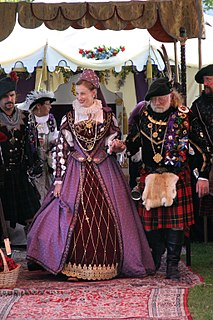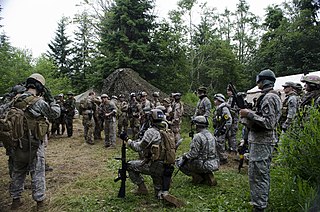
Historical reenactment is an educational or entertainment activity in which mainly amateur hobbyists and history enthusiasts dress in historic uniforms or costumes and follow a plan to recreate aspects of a historical event or period. This may be as narrow as a specific moment from a battle, such as the reenactment of Pickett's Charge presented during the Great Reunion of 1913, or as broad as an entire period, such as Regency reenactment.

Living history is an activity that incorporates historical tools, activities and dress into an interactive presentation that seeks to give observers and participants a sense of stepping back in time. Although it does not necessarily seek to reenact a specific event in history, living history is similar to, and sometimes incorporates, historical reenactment. Living history is an educational medium used by living history museums, historic sites, heritage interpreters, schools and historical reenactment groups to educate the public or their own members in particular areas of history, such as clothing styles, pastimes and handicrafts, or to simply convey a sense of the everyday life of a certain period in history.

Authenticity is a concept of personality in the fields of psychology, existential psychotherapy, existentialist philosophy, and aesthetics. In existentialism, authenticity is the degree to which a person's actions are congruent with his or her values and desires, despite external pressures to social conformity. The conscious Self comes to terms with the condition of Geworfenheit, of having been thrown into an absurd world not of his or her own making, thereby encountering external forces and influences different from and other than the Self. In human relations, a person’s lack of authenticity is considered bad faith in dealing with other people and with one's self; thus, authenticity is in the instruction of the Oracle of Delphi: “Know thyself.”

A Renaissance fair, Renaissance faire or Renaissance festival is an outdoor weekend gathering open to the public and typically commercial in nature, which purportedly recreates a historical setting for the amusement of its guests. Some are permanent theme parks, while others are short-term events in a fairground, winery, or other large public or private spaces. Renaissance fairs generally include an abundance of costumed entertainers or fair-goers, musical and theatrical acts, art and handicrafts for sale, and festival food. Some offer campgrounds for those who wish to stay more than one day.

American Civil War reenactment is an effort to recreate the appearance of a particular battle or other event associated with the American Civil War by hobbyists known as Civil War reenactors, or living historians.

Medieval reenactment is a form of historical reenactment that focuses on re-enacting European history in the period from the fall of Rome to about the end of the 15th century. The second half of this period is often called the Middle Ages. This multiplicity of terms is compounded by the variety of other terms used for the period.

Olustee Battlefield Historic State Park is a Florida State Park in the Osceola National Forest, near the town of Olustee. The site of Florida's largest Civil War battle, the Battle of Olustee. The park is located 50 miles (80 km) west of Jacksonville and 15 miles (24 km) east of Lake City, on U.S. 90. It also has the distinction of being the first park in the Florida State Park system.
Classical reenactment tends to focus on portrayals of the Greco-Roman world, and especially on modern recreations of Roman legions and ancient Greek hoplites.
The Society for Creative Anachronism (SCA) is a medieval reenactment group with an international membership, founded in California in 1966. Members of the group participate, to a greater or lesser extent, in a wide variety of activities based on those found in pre-1601 CE cultures. The vast majority of interests in the SCA are either combat-focused, or focused on the day-to-day crafts of the period, known within the Society as A&S. Gatherings of the SCA are events, at which attempts at pre-17th century costume must be worn, and practices or meetings, at which costuming is largely up to each member's discretion—although sufficient safety equipment must always be worn for practicing combat skills.
A tactical event is a type of historical reenactment, not usually open to the public, which is fought like a real battle with each side devising strategies and tactics to defeat their opponent(s). Tactical events have no script, a basic set of agreed-upon rules, and onsite judges or referees, and so could be considered a form of live action role-playing game. Tactical battles might also be considered a form of experimental archaeology.

MilSim, an abbreviation of military simulation, refers to live-acted simulation of armed conflict scenarios conducted by civilians for entertainment, sporting or nostalgic purposes. It has been described as both a form of "extreme sport" and as historical reenactment.

Middelaldercentret is an experimental living history archaeological open-air museum in Denmark, which depicts the middle ages in the Denmark of the late 14th and early 15th centuries. It is located in Sundby Lolland, some 4 km northwest of the centre of Nykøbing Falster on the waterfront of Guldborgsund.

Similar to a World War II reenactment, Korean War reenactments can be divided into two categories, "living history" or a public-oriented display or as a "tactical event", a closed event where participants re-create a battle or event of the war.
The Vikings - Vinland is an organization of Viking reenactors, consisting of 12 local member-groups across North America which, in 2006, were united into one governing body... The Vikings. All members of Vinland are full members of a larger society known as The Vikings. Members focus on developing and presenting the reconstructed culture and lifestyle of the Norse. While the major concentration is on the 10th Century, some events are set in the wider period from 790 to 1066, with the appropriate modifications to dress and equipment used. The organization's aim is to provide an accurate and educational portrayal of the Viking period, with an equal emphasis on the daily life of the period, and on the more warlike aspects of life in what was a formative period in European history. The organization was renamed to The Vikings - Vinland in 2020 to better reflect the diverse North American membership of the group. www.vikingsvinland.org

Regency reenactment is historical reenactment of the British Regency period. Groups portray the period from 1811 to 1820 through costume, manners, food, and social gatherings that celebrate the spirit of the era.

A live-action game (LAG) is a game where the participants act out their characters' actions.

Authenticity in art is manifest in the different ways that a work of art, or an artistic performance, can be considered authentic. The initial distinction is between nominal authenticity and expressive authenticity. In the first sense, nominal authenticity is the correct identification of the author of a work of art; of how closely an actor or an actress interprets a role in a stageplay as written by the playwright; of how well a musician's performance of an artistic composition corresponds to the composer's intention; and how closely an objet d’art conforms to the artistic traditions of its genre. In the second sense, expressive authenticity is how much the work of art possesses inherent authority of and about its subject, and how much of the artist's intent is in the work of art.
The American Civil War Centennial was the official United States commemoration of the American Civil War, also known as the War Between the States. Commemoration activities began in 1957, four years prior to the 100th anniversary of the commencement of hostilities, and ended in 1965 with the 100th anniversary of the surrender at Appomattox.

Renaissance reenactment is historical reenactment of events of the Renaissance period and the European Age of Exploration. In its broadest use, it encompasses reenactment of periods from the early 15th century through the mid-18th century. Reenactments of earlier events are commonly termed medieval reenactment, while more recent events are modern reenactment. Events and periods within Renaissance reenactment vary by region and nation, but include the English Civil War in the United Kingdom, the Eighty Years' War in the Low Countries, L'Escalade in Switzerland, the Polish–Lithuanian Commonwealth in eastern Europe, and the early colonial period in the United States and Canada.

The commemoration of the American Civil War is based on the memories of the Civil War that Americans have shaped according to their political, social and cultural circumstances and needs, starting with the Gettysburg Address and the dedication of the Gettysburg cemetery in 1863. Confederates, both veterans and women, were especially active in forging the myth of the Lost Cause of the Confederacy.
















